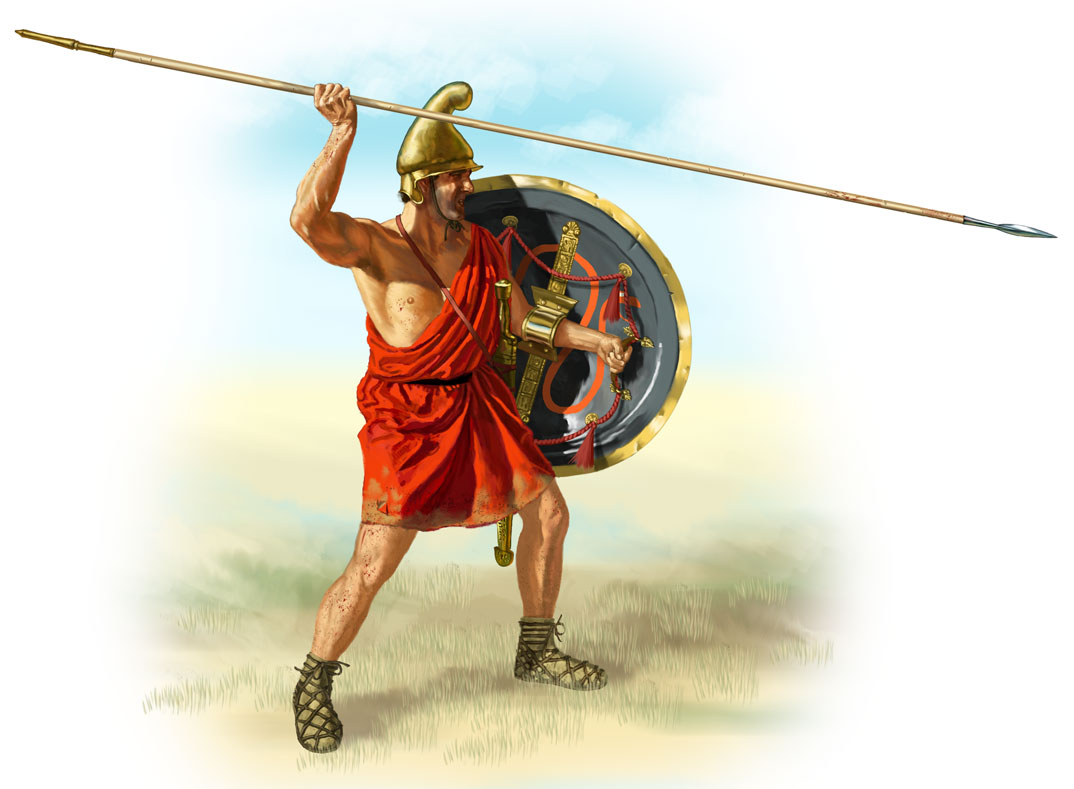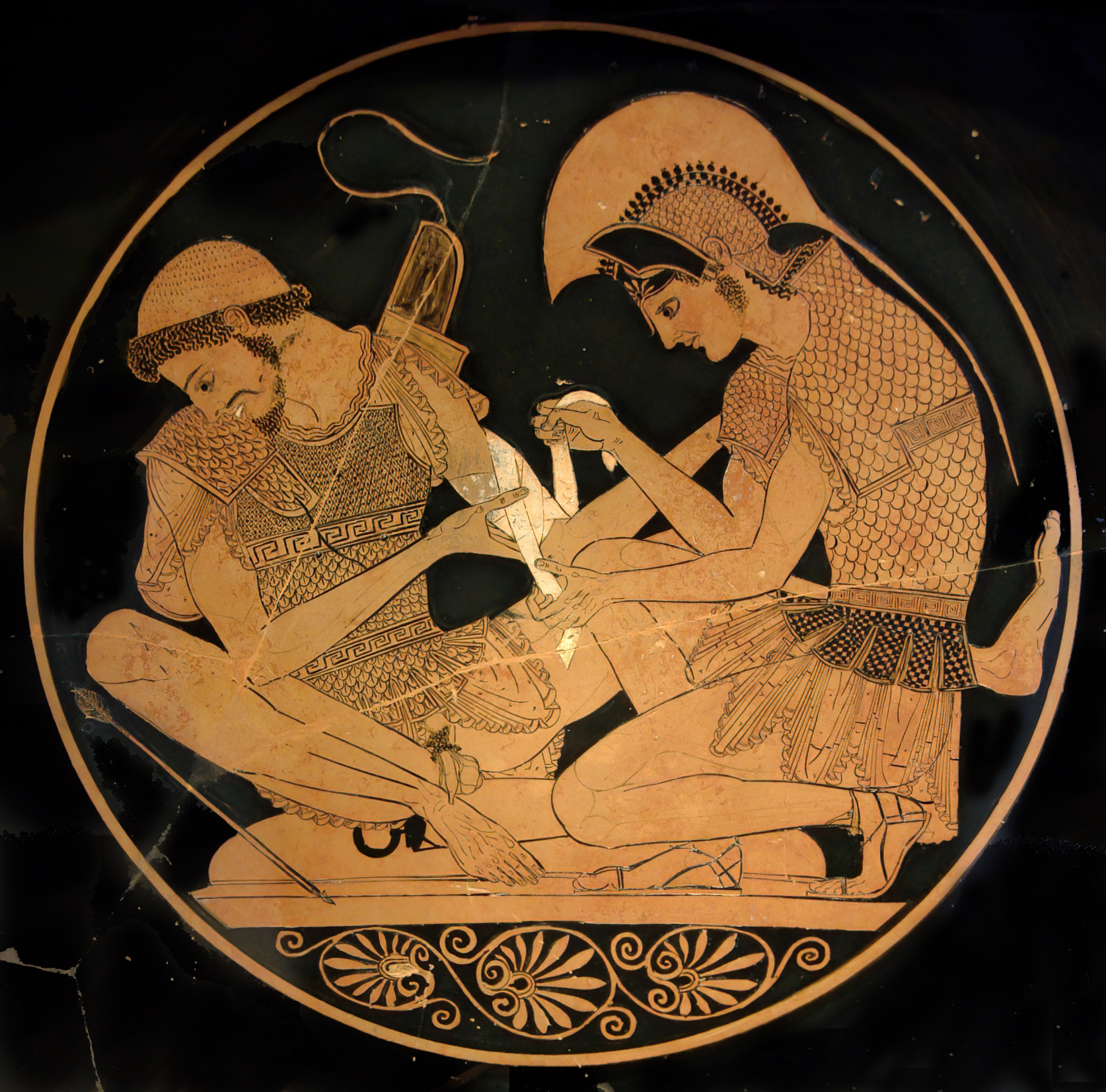|
Kotthybos
Kotthybos () was a type of Macedonian body armour. Etymology The name originally referred to a metallic cooking pot used by ancient Macedonian soldiers to prepare their own food. The term appears to be a variant of terms such as ''kossymbos'' and ''kosymbe''. Use and possible construction Ancient sources are unclear as to the form of the ''kotthybos'', but the context of references to it indicates that it was a form of armour associated with the 'Foot Companions' ('' Pezhetairoi'') who formed the Macedonian phalanx. It is recorded that the fine of 2 obols imposed on a soldier for losing a ''kotthybos'', was the same as for the '' konos'', a simple, conical, bronze helmet, and less than for the ''sarissa'', a long pike. Modern scholars are divided as to what the ''kotthybos'' was; some consider it a padded garment worn under other forms of armour, whilst the majority regard it an alternative term for the ''spolas'' or'' linothorax'' (neologism), the typical Hellenic and Hellenis ... [...More Info...] [...Related Items...] OR: [Wikipedia] [Google] [Baidu] |
Ancient Macedonian Army
The Kingdom of Macedon possessed one of the greatest armies in the ancient world. It is reputed for the speed and efficiency with which it emerged from Greece to conquer large swathes of territory stretching from Egypt in the west to India in the east. Initially of little account in the Greek world, it was widely regarded as a second-rate power before being made formidable by Philip II, whose son and successor Alexander the Great conquered the Achaemenid Empire in just over a decade's time. The latest innovations in weapons and tactics were adopted and refined by Philip, and he created a uniquely flexible and effective army. By introducing military service as a full-time occupation, Philip was able to drill his men regularly, ensuring unity and cohesion in his ranks. In a remarkably short time, this led to the development of one of what was among the world's finest military machines for the era. Tactical improvements included the latest developments in the deployment of the tra ... [...More Info...] [...Related Items...] OR: [Wikipedia] [Google] [Baidu] |
Macedon
Macedonia ( ; , ), also called Macedon ( ), was an ancient kingdom on the periphery of Archaic and Classical Greece, which later became the dominant state of Hellenistic Greece. The kingdom was founded and initially ruled by the royal Argead dynasty, which was followed by the Antipatrid and Antigonid dynasties. Home to the ancient Macedonians, the earliest kingdom was centered on the northeastern part of the Greek peninsula,. and bordered by Epirus to the southwest, Illyria to the northwest, Paeonia to the north, Thrace to the east and Thessaly to the south. Before the 4th century BC, Macedonia was a small kingdom outside of the area dominated by the great city-states of Athens, Sparta and Thebes, and briefly subordinate to Achaemenid Persia. During the reign of the Argead king PhilipII (359–336 BC), Macedonia subdued mainland Greece and the Thracian Odrysian kingdom through conquest and diplomacy. With a reformed army containing phalanxes wielding the ... [...More Info...] [...Related Items...] OR: [Wikipedia] [Google] [Baidu] |
Konos
Konos (: ''cone, spinning top'') is a conical Macedonian helmet worn in combat during the Hellenistic era. Its pointed shape is similar to the pilos helmet that is placed underneath a konos as an interior protector. Although close in design, a pilos helmet has a small visor around the opening and a konos helmet is created to have a thin brim protruding from its base and closely fits around the warrior's head. Bronze ear guards that hang to the jawbone were later added for further protection, also differing from the pilos. Spiral characteristics from the Ionic order are engraved across the front of the helmet for design. The Greek crest is fixed across the ridges of the helmet as a way to demonstrate tribe recognition. The konos and pilos helmet belong to one of five standard types of ancient Greek headgear and weaponry. A clause of military regulation from Amphipolis proclaims that the konos is to be the helmet of phalangites—infantry standing in close rectangular or squared fo ... [...More Info...] [...Related Items...] OR: [Wikipedia] [Google] [Baidu] |
Agios Athanasios 1 Fresco
''Agios'' (), plural ''Agioi'' (), transcribes masculine gender Greek words meaning 'sacred' or 'saint' (for example Agios Dimitrios, Agioi Anargyroi). It is frequently shortened in colloquial language to ''Ai'' (for example Ai Stratis). In polytonic script it is written ''Hagios'' () (for example Hagios Demetrios). It is also transliterated as, inter alia, ''Haghios'', ''Ayios'', ''Aghios'' (for example Ayios Dhometios, Aghios Andreas Beach, respectively) in the singular form, and ''Haghioi'', ''Ayioi'', ''Aghioi'', ''Ayii'' in the plural (for example Ayioi Omoloyites, Nicosia, Aghioi Theodoroi, Ayii Trimithias respectively). The feminine is ''agia'', ''ayia'', ''aghia'', ''hagia'' or ''haghia'' (Greek: or in polytonic form ), for example ''Agia Varvara'' (Saint Barbara). See also * * Agia (other), the feminine form of the word in Greek * Agis (other) * Agii (other) * Agius, a surname * ''Agos'', an Armenian newspaper * Agoi, a clan and language s ... [...More Info...] [...Related Items...] OR: [Wikipedia] [Google] [Baidu] |
Pezhetairoi
The pezhetairoi (Greek: , singular: ''pezhetairos)'' were the backbone of the Macedonian army and Diadochi kingdoms. They were literally "foot companions" (in Greek, ''pezos'' means "pedestrian" and ''hetairos'' means "companion" or "friend"). The Macedonian phalanxes were made up almost entirely of pezhetairoi. Pezhetairoi were very effective against both enemy cavalry and infantry, as their long pikes could be used to impale enemies charging on horseback or to keep enemy infantry with shorter weapons at bay. Description The pezhetairoi were the battalions of the Macedonian phalanx. They first came to prominence during the reign of Philip II, particularly when they played important role in Philip's subjugation of Greece at the Battle of Chaeronea in 338 BC. Philip created this unit by lengthening the spear to the point of becoming a true pike, removing the heavy armor, and replacing the large shield with a smaller alternative. They were armed with the sarissa, a long spear ... [...More Info...] [...Related Items...] OR: [Wikipedia] [Google] [Baidu] |
Obol (coin)
The obol (, ''obolos'', also ὀβελός (''obelós''), ὀβελλός (''obellós''), ὀδελός (''odelós''). "nail, metal spit"; ) was a form of ancient Greek currency and weight. Currency Obols were used from early times. According to Plutarch they were originally spits of copper or bronze traded by weight, while six obols make a drachma or a handful, since that was as many as the hand could grasp. Heraklides of Pontus (died 310 BC) is cited as having mentioned the obols of Heraion and also gives the etymology of ''obolos'' (the name of the coin) from ''obelos'' (the word for "spit, spike, nail"). Similarly, the historian Ephorus in his equally lost work ''On Inventions'' (mid 4th century BC) is said to have mentioned the obols of Heraion. Excavations at Argos discovered several dozen of these early obols, dated well before 800 BC; they are now displayed at the Numismatic Museum of Athens. Archaeologists today describe the iron spits as "utensil- ... [...More Info...] [...Related Items...] OR: [Wikipedia] [Google] [Baidu] |
Sarissa
The sarissa or sarisa was a long spear or pike about in length. It was introduced by Philip II of Macedon and was used in his Macedonian phalanxes as a replacement for the earlier dory, which was considerably shorter. These longer spears improved the strength of the phalanx by extending the rows of overlapping weapons projecting towards the enemy. After the conquests of Alexander the Great, the sarissa was a mainstay during the Hellenistic era (4th–1st centuries BCE) by the Hellenistic armies of the diadochi Greek successor states of Alexander's empire, as well as some of their rivals. Composition and utility The sarissa is made of two core parts: a long wooden shaft and a metal tip. A third part that may have existed for some sarissas was a metal spear-butt at the reverse end. The metal butt of the sarissa could be used to safely stow it in the ground without damaging the shaft when not in use. Two types of wood are favored as likely candidates for the shaft: ... [...More Info...] [...Related Items...] OR: [Wikipedia] [Google] [Baidu] |
Linothorax
The ''linothorax'' (, from the , ) is a type of upper body armor that was used throughout the ancient Mediterranean world. The term ''linothorax'' is a modern term based on the Greek , which means "wearing a breastplate of linen"; a number of ancient Greek and Latin texts from the 6th century BC to the third century AD mention () (Greek) or (Latin) which means 'linen body armour'. These are usually equated with some of the armour shown in sculptures and paintings from Italy and Greece from 575 BC onwards. Very little is known about how ancient linen armour was made. Linen armour in other cultures was usually quilted and stuffed with loose fibre or stitched together many layers thick, but it could also have been made with a special weave called twining which creates a thick, tough fabric. The theory that it was made of layers of linen glued together comes from a mistranslation of a summary of a description of medieval armour in 1869. By the late 6th century BC, many paintings and ... [...More Info...] [...Related Items...] OR: [Wikipedia] [Google] [Baidu] |
Alexander The Great
Alexander III of Macedon (; 20/21 July 356 BC – 10/11 June 323 BC), most commonly known as Alexander the Great, was a king of the Ancient Greece, ancient Greek kingdom of Macedonia (ancient kingdom), Macedon. He succeeded his father Philip II of Macedon, Philip II to the throne in 336 BC at the age of 20 and spent most of his ruling years conducting Wars of Alexander the Great, a lengthy military campaign throughout West Asia, Western Asia, Central Asia, parts of South Asia, and ancient Egypt, Egypt. By the age of 30, he had created one of the List of largest empires, largest empires in history, stretching from History of Greece, Greece to northwestern History of India, India. He was undefeated in battle and is widely considered to be one of history's greatest and most successful military commanders. Until the age of 16, Alexander was tutored by Aristotle. In 335 BC, shortly after his assumption of kingship over Macedon, he Alexander's Balkan campaign, campaigned in the Bal ... [...More Info...] [...Related Items...] OR: [Wikipedia] [Google] [Baidu] |
Ancient Greek Military Terminology
Ancient history is a time period from the beginning of writing and recorded human history through late antiquity. The span of recorded history is roughly 5,000 years, beginning with the development of Sumerian cuneiform script. Ancient history covers all continents inhabited by humans in the period 3000 BCAD 500, ending with the expansion of Islam in late antiquity. The three-age system periodises ancient history into the Stone Age, the Bronze Age, and the Iron Age, with recorded history generally considered to begin with the Bronze Age. The start and end of the three ages vary between world regions. In many regions the Bronze Age is generally considered to begin a few centuries prior to 3000 BC, while the end of the Iron Age varies from the early first millennium BC in some regions to the late first millennium AD in others. During the time period of ancient history, the world population was exponentially increasing due to the Neolithic Revolution, which was in full prog ... [...More Info...] [...Related Items...] OR: [Wikipedia] [Google] [Baidu] |







